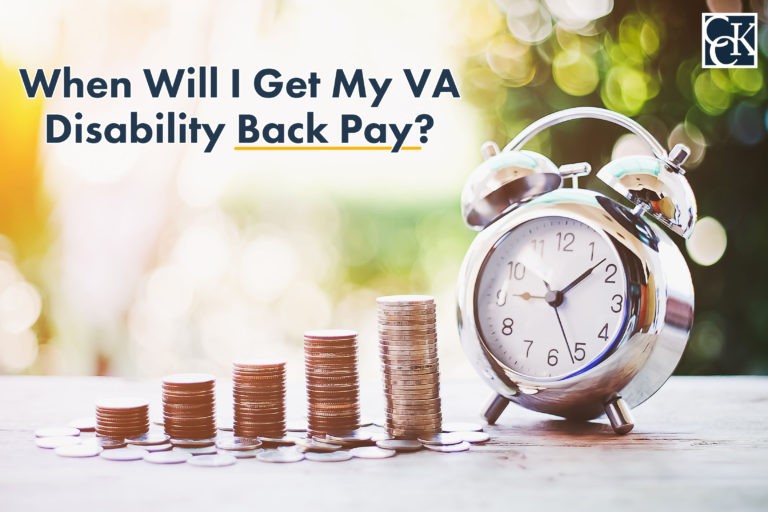When Will I Get My VA Disability Back Pay?

CCK Law: Our Vital Role in Veterans Law
What is VA Disability Back Pay?
VA disability back pay is the monies owed to veterans from the effective date of their claim, to the date they were granted those benefits. Typically, when it grants a decision in favor of the veteran’s claim, VA will pay the veteran from the date the claim was filed. However, in some instances, the effective date may be different than the date the claim was filed.
Due to the backlog of disability compensation claims and appeals, VA can often take months or years to grant benefits. Generally speaking, the longer VA takes to decide your claim, the more back pay it owes you in order to compensate you all the way back to your effective date.
What Are Effective Dates?
An effective date is the start date that VA uses to begin payments. VA grants effective dates based on either the date it received the veteran’s claim, or the date that entitlement arose (e.g., date a veteran was diagnosed with the condition they are claiming). Retroactive benefits, or back pay, will be paid to the veteran starting from the effective date. Going forward, VA will also pay the veteran the rate they were awarded in the decision on a monthly basis.
Common Misconceptions About VA Back Pay
Common misconceptions about VA back pay include the following:
- VA will pay veterans all the way back to the date of the injury or event in service; and
- VA will pay veterans all the way back to the date of their discharge.
VA does not consider the date of an event or injury as the effective date for those who apply for disability compensation after they have separated from service. Furthermore, VA will only grant benefits back to the date of discharge for service members who apply for benefits within a year of their military discharge. As mentioned above, the effective date is most often the same date that VA received the veteran’s claim.
Complications to Effective Dates
As mentioned above, the effective date is most often the same date that VA received the veteran’s claim. Reviewing the evidence cited by VA in the decision issued can help veterans understand what date VA is using as the effective date. This is especially important in claims for increased ratings, where VA might cite the date the condition worsened. Often, the effective date used by VA does not correspond to the actual date the veteran’s condition increased in severity, so the veteran may want to appeal for an earlier effective date.
In some instances, the veteran’s effective date may predate the date the veteran filed the claim. Sometimes VA laws change, and certain conditions are added to the list of presumptive conditions. If VA receives a claim from a veteran for such a condition more than one year after the law changed, then the effective date can be up to one year before VA received the claim.
Another instance where the veteran’s effective date may predate the date the veteran filed the claim is if additional service records containing relevant evidence have become available. These records must be official, such as those gathered from the Department of Defense or VA archives, and new, meaning that they have never been included in the veteran’s claim’s file.

How Much Back Pay Will I Receive?
The amount of back pay a veteran will receive depends on the effective date of their claim, and the disability rating that they are granted by VA. Typically, the higher the disability rating, the more back pay will VA owe. To calculate a veteran’s back pay over the course of multiple years, VA looks to its historical compensation rate tables.
VA disability compensation rates may change each year pursuant to the Cost of Living Adjustment (COLA) set forth by the Social Security Administration. Veterans receiving back pay are paid the compensation amounts respective to each year. For example, a single veteran with no dependents rated at 50 percent would receive $770 per month in 2010 and $855.41 per month in 2018. Importantly, there is no limit to the amount of back pay a veteran can receive.
As of December 1st, 2024, the VA disability rate benefit amounts are as follows:
- 0 percent disability rating: $0.00 per month
- 10 percent disability rating: $175.51 per month
- 20 percent disability rating: $346.95 per month
- 30 percent disability rating: $537.42 per month
- 40 percent disability rating: $774.16 per month
- 50 percent disability rating: $1,102.04 per month
- 60 percent disability rating: $1,395.93 per month
- 70 percent disability rating: $1,759.19 per month
- 80 percent disability rating: $2,044.89 per month
- 90 percent disability rating: $2,297.96 per month
- 100 percent disability rating: $3,831.30 per month
Calculating VA Back Pay Using the VA Disability Retro Calculator
Chisholm Chisholm & Kilpatrick LTD’s VA disability retro calculator is designed to help veterans estimate the amount of VA disability back pay they might be due based on the factors described above. The VA disability retro calculator calculates your back pay by asking several straightforward questions.
Veterans simply type in the answers to get an immediate estimate. If you recently received a grant resulting in VA disability back pay, you may want to use the calculator to get an idea of how much money you will receive.
Receiving VA Disability Back Pay
VA back pay is paid to the veteran all at once in a single lump sum following a grant of benefits. This is different from all other benefits awarded in connection with the veteran’s claim, referred to as future benefits, which are paid on a monthly basis.
VA maintains that veterans should receive VA back pay within 15 days of the decision granting the retroactive benefits either through direct deposit or a check. However, it is not uncommon for VA to take several months to issue back pay and retroactive benefits. Therefore, it may be beneficial to work with a veterans’ disability lawyer to ensure you receive your VA back pay in a timely manner.
There are some circumstances that may complicate when the veteran receives their back pay. Below are some complications which may lengthen the time it takes a veteran to receive their back pay:
- The veteran’s address is not up to date—Failing to keep VA informed of the current address, banking information, or contact information could mean significant delays to the amount of time it takes the veteran to receive their back pay.
- The veteran has a fiduciary—Fiduciaries are often delegated in instances where the veteran has been found incompetent or incapable of handling their own finances. The fiduciary then is placed in charge of the veteran’s benefits. Sometimes a fiduciary will have to be chosen before the veteran receives their benefits. If a fiduciary has already been chosen, the veteran’s back pay will be issued to the fiduciary. Importantly, a veteran may challenge a VA incompetency proposal.
- The veteran received staged ratings throughout the retroactive benefits period—Sometimes a veteran receives a decision granting them different rating levels for different periods of time, based on the severity of the veteran’s condition(s) over time. Most often this happens in claims for increased ratings. VA refers to this as staged ratings. When staged ratings have been issued, it may take VA longer to calculate the ratings, since they are different for multiple time periods. The longer it takes VA to make the calculations, the longer the veteran may have to wait to receive the award.
- The veteran was granted entitlement to a large retroactive sum—Similar to staged ratings, the more complicated the calculations VA has to make, the longer it could take for the veteran to receive their benefits. If the veteran’s effective date covers a long period of time, VA may take longer to calculate the amount of money awarded to the veteran over that period. Additionally, the monetary award associated with each rating level has changed over time. This means that the compensation at the 50 percent rating level in the year 1990 is different than the 50 percent rating level in 2021. VA must calculate the changes in compensation over these years. Again, the longer it takes VA to make these calculations, the longer it will be before the veteran receives their back pay.
- The veteran was receiving severance pay, retirement pay, or other disability benefits during this time—In instances where the veteran is eligible for retroactive benefits, but was also receiving severance pay, retirement pay, or other disability benefits during that time, VA will have to subtract those payments from the amount of retroactive benefits. These additional calculations can again add time to the process, delaying when the veteran receives their back pay.
Getting Additional Assistance with Denied VA Claims
Sometimes the path to receiving back pay can be long and arduous. If you need assistance filing an appeal the team of veterans’ lawyers at Chisholm Chisholm & Kilpatrick LTD may be able to help. For a free case evaluation with a member of our staff, call us at 800-544-9144.
About the Author
Share this Post
